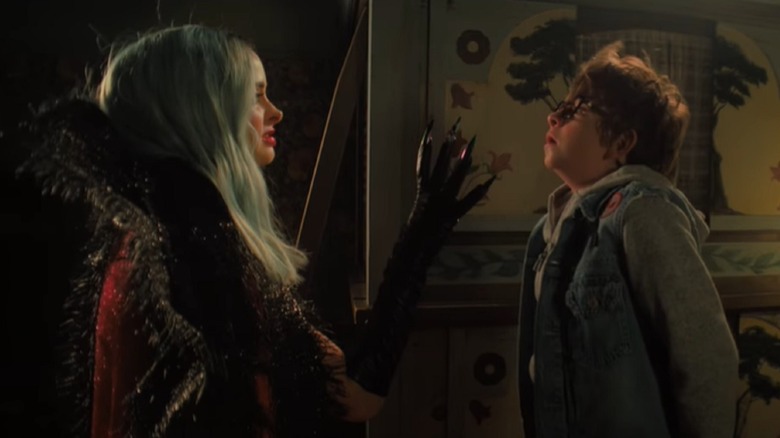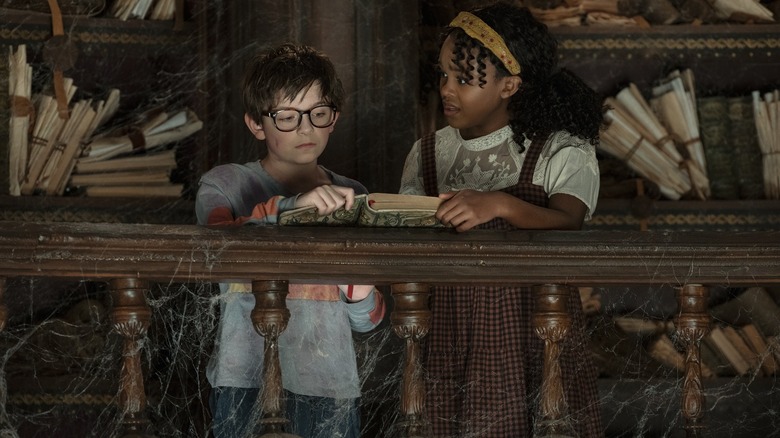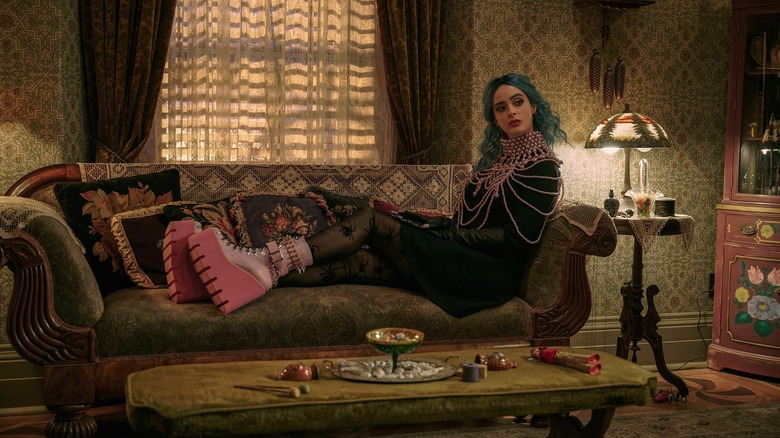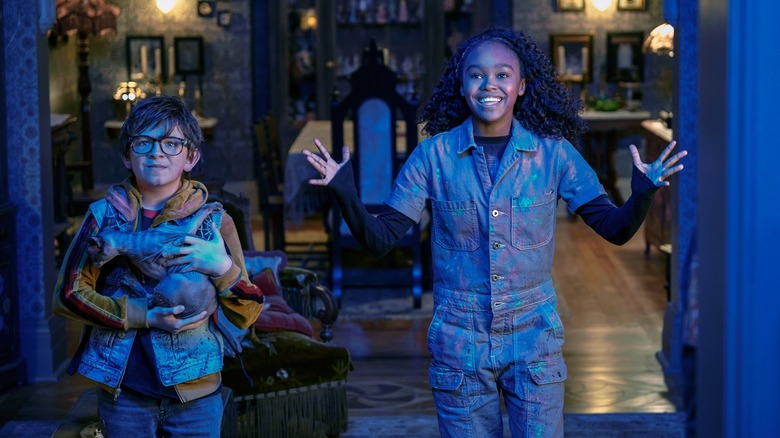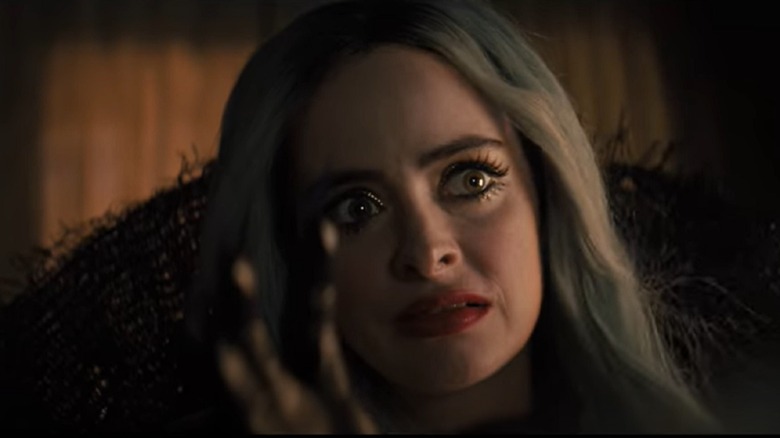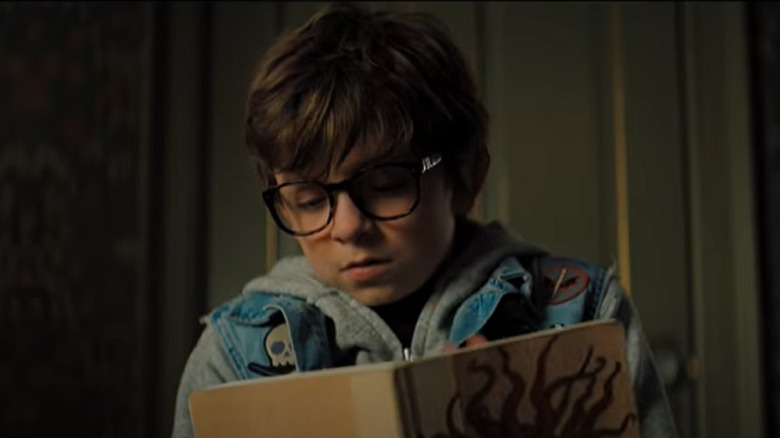Easter Eggs And Fairy Tale References In Nightbooks
This content was paid for by Netflix and created by Looper.
No matter how much you like scary stories, chances are you don't want to ever find yourself in the middle of one. But that's exactly what happens to poor Alex (Winslow Fegley) in "Nightbooks" when the kid suddenly finds himself lured into the witch Natacha's (Krysten Ritter) magical apartment and faces certain doom if he doesn't come up with a new terror tale to read to her each night.
Alex is initially ready to burn his nightbooks, a collection of original spooky stories, after being labeled a "creepshow" by his peers at school and left to celebrate his haunted house-themed birthday party all alone. But suddenly, those creative shorts become his lifeline as he uses them to keep the witch at bay while he and fellow captive Yasmin (Lidya Jewett) team up to find a way out of their seemingly inescapable prison.
If the concept of witches and captive children sounds like something straight out of a fairytale, well, that's because "Nightbooks" purposefully brings together elements of some of the most famous classic stories of all time. Let's take a look at the fairytale references and other Easter eggs that you might notice in "Nightbooks."
An ominous entrance
Before we dig into the literary lore that lurks throughout the film, there's a major Easter egg that pops up before Alex enters the witch's apartment and signals that something terrible is about to happen to him. Sure, he maybe should have known that already, given the fact that he only arrives at this menacing little manor after his elevator has a bit of a hiccup and lands him on this dark and dreary hallway. But the danger within is really hinted at right there on the door.
That's right — the very number of the witch's apartment serves as a major warning sign about the fate of anyone who enters, since she lives in 4E, which is something of a modern-day abbreviation for the word "forever." As in, Alex is going to be stuck in this apartment forever if he enters. Granted, there are a lot of ordinary people around the world who live in apartments numbered 4E and don't collect children in curio cabinets, so it's understandable why that little hint didn't scare Alex away. But still, you'd think a kid who's seen so many horror movies as him might get the memo to beware. Talk about a live and learn experience.
An alluring taste
One of the reasons Alex does decide to wander into the unfamiliar apartment is that the door is wide open and there's a personalized attraction that gets his attention. "The Lost Boys," which is clearly one of his favorite movies judging by his prominent bedroom poster of the pic, is playing on a television right in the middle of the front room, just begging for an audience. Meanwhile, there's a slice of (poisoned) pumpkin pie sitting right there, looking too tasty to resist.
Though it was a very different type of food item that drew Yasmin into the apartment years before — the smell of her beloved grandma's signature doro wat recipe did the trick with her — the use of pie with Alex is no accident. It serves as a bit of a wink to "The Pied Piper of Hamelin," a folk tale from the Middle Ages about — you guessed it — a piper who takes out his terrible revenge on the entire town of Hamelin after they refuse to pay for him for luring all of the rats away. Much like the apartment uses individual siren songs to steal unsuspecting children, the pied piper gets payback against the people that have stiffed him by leading all of the children away with his handy wind instrument. That's why you gotta pay the piper and don't take pie from strangers.
A reluctant storyteller
Once Alex does meet the witch Natacha inside the apartment, she makes it clear that unless he can do something useful for her, she's going to get rid of him right there on the spot. Fortunately, Alex's one talent is the very thing she needs, as she's already exhausted all the scary stories in her heaping library and could use a few new unhappy endings to mix things up.
This part of the plot might remind you of "One Thousand and One Nights," an ancient Middle Eastern folk tale that centers on a vengeful king named Shahryār, who marries and immediately murders many young women after a betrayal by his wife. When the Vizier runs out of new brides to send to the king, his own daughter Scheherazade volunteers to be next, and she manages to survive by telling him nightly stories with cliffhangers so he will want to hear the rest the next day. Just as her fantastic tales about Aladdin, Sinbad, and many other legendary characters keep Scheherazade alive, Alex's own stories are what will keep him from the witch's wrath — just as long as he can keep the creative juices flowing under pressure, that is.
A dynamic duo
There might not be any breadcrumb trails in "Nightbooks," but there are plenty of other references to one of the most enduring Brothers Grimm fairytales: "Hansel and Gretel." Its influence on the story can be seen throughout the film, though some references to this famed fable are a lot more noticeable than others.
It's hard to miss, for example, the fact that Alex actually turns to a very vintage copy of "Hansel and Gretel" for clues to his own survival, and several pieces of the story's images come to life as he and Yasmin find themselves drawn to the intoxicating treats in the witch's forest gingerbread house and have to trick the real witch who eats children into diving into the burning oven. However, some of the winks to "Hansel and Gretel" are a little more subtle; look closely around the magical apartment, and you might notice that much of the décor is woodlands-themed, fit with an oven-shaped bunk bed entryway and all. There are also candy shapes sprinkled into the mix, such as the peppermint pinwheel-styled floor patterns in the den. The fact that Yasmin's dress looks just like what Gretel wears is just icing on the cake, so to speak.
A hidden threat
There are plenty of other creatures of fantasy that come into play throughout "Nightbooks," including the enchanted spy cat Lenore, Natacha's evil unicorn creation, and those terrible "Pinocchio"-in-reverse wood dolls. You also might notice a few other famous fables that get major mentions throughout the film as well, including "Rumplestiltskin," "The Frog King," Mary Shelley's Frankenstein, and H.P. Lovecraft's "Dagon."
The one that gets called out by name, almost as prominently and often as "Hansel and Gretel" does, is "Sleeping Beauty." Not only is it one of the stories Alex encounters in the massive library, but Natacha also teasingly calls Alex by that name when he awakens from his treat-induced slumber to find himself still trapped in the apartment. And it's no coincidence that "Sleeping Beauty" gets so much recognition throughout the story; as we learn in the final act, Natacha has taken a leaf out of that tale's playbook, enchanting the original witch that took her captive by keeping her under a sleeping spell. Only this time, it's not true love's kiss that awakens the sleeping lady, and she's definitely no beauty — instead, it's the very utterance of a story with a happy ending that breaks the spell and leads to the big "witch fight."
A sliver of cinema
It's not just written works that have an impact on the story in "Nightbooks." There are also some meaningful cinematic references to be found in the film as well. "The Lost Boys" is given some serious attention, for example, and also serves as a bit of a metaphor for what Alex and Yasmin go through after being abducted by the witch and refusing to give into this terrible new lifestyle forever.
Then we see a prominent poster for "The Thing," which may be a wink to the sense of survivalism and the seeds of distrust that emerge between Alex, Yasmin, and Lenore before they truly become friends. Meanwhile, that "Child's Play 2" poster in the backdrop of Alex's room is a clever nod to all the kids who were made into toys before Alex's arrival to the apartment, and the close-up shot of Alex's "The People Under the Stairs" poster is a clear wink to that Wes Craven favorite, in which a group of burglars stumbles into a house full of kidnapped and abused children who have to finally team up to fight back against their captors.
Last but certainly not least, the cruel nickname that Alex is given by his classmates is actually quite appropriate — and maybe even a compliment, really. After all, the 1982 horror-comedy film of the same name, from Stephen King and George A. Romero, features a series of horror vignettes, much like what Alex himself has created with his nightbooks, and "Creepshow" is bookended by the story of a boy who is ridiculed for his love of horror comics — and in his own gnarly little way, decides to embrace who he is, regardless of what others think of his obsession. Just as Alex comes to love himself for being a "weirdo" horror fanatic, so does the pint-sized star of the "Creepshow" prologue and epilogue.
